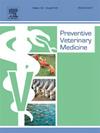Exploring structural changes in the Swedish cattle population and between-holding movements
IF 2.4
2区 农林科学
Q1 VETERINARY SCIENCES
引用次数: 0
Abstract
Movements of livestock between holdings plays an important role in the spread of many infectious diseases, and network analysis can provide a greater understanding of potential spread dynamics. This study explored cattle movements between Swedish holdings from 2005 to 2022 to enhance the knowledge basis for epidemiological analyses.
In addition to classical network analysis, a novel method, Location Change Pattern (LCP), was used to analyse movements between holdings per individual. Furthermore, survival analysis was used to investigate animal- and herd level risk factors associated with moving cattle from a holding.
Although the number of cattle and holdings decreased, the number of movements increased substantially over the study period. Simultaneously, the network became more disassortative with an increased average path length, whilst indegree and in- and outgoing contact chains decreased. Combined, the results suggests that an epidemic spread in the cattle population may be slower and reach a smaller final size compared to 2005. Additionally, the clustering coefficient and reciprocity increased over time which might change the dynamics of disease spread. The increase in movements can be partly explained by an increased number of cattle being moved back and forth between holdings, particularly seen for female cattle. Male calves at holdings with a high proportion of female cattle had the greatest hazard of being moved, with an increased hazard at around 20 days of age.
In summary, significant changes over time were found in the cattle population and in the movement network, which must be accounted for when working with disease prevention.
探索瑞典牛种群的结构变化和饲养运动之间的变化
牲畜在饲养场之间的流动在许多传染病的传播中起着重要作用,网络分析可以更好地了解潜在的传播动态。本研究探讨了2005年至2022年瑞典牧场之间的牛流动,以增强流行病学分析的知识基础。在传统的网络分析的基础上,采用了一种新的方法——位置变化模式(LCP)来分析个体持有之间的移动。此外,生存分析用于调查动物和畜群水平的风险因素,这些风险因素与将牛从牧场移走有关。在研究期间,虽然牛的数量和牲畜的数量减少了,但迁徙的数量却大大增加了。同时,随着平均路径长度的增加,网络变得更加不协调,而程度和内外接触链减少。综合起来,结果表明,与2005年相比,流行病在牛群中的传播速度可能更慢,最终规模可能更小。此外,聚类系数和互易性随着时间的推移而增加,这可能会改变疾病传播的动态。运动增加的部分原因可以解释为在牧场之间来回移动的牛的数量增加,特别是在雌性牛中。在母牛比例较高的畜群中,雄性小牛被转移的风险最大,在20日龄左右风险增加。总而言之,随着时间的推移,牛的数量和流动网络发生了重大变化,在开展疾病预防工作时必须考虑到这一点。
本文章由计算机程序翻译,如有差异,请以英文原文为准。
求助全文
约1分钟内获得全文
求助全文
来源期刊

Preventive veterinary medicine
农林科学-兽医学
CiteScore
5.60
自引率
7.70%
发文量
184
审稿时长
3 months
期刊介绍:
Preventive Veterinary Medicine is one of the leading international resources for scientific reports on animal health programs and preventive veterinary medicine. The journal follows the guidelines for standardizing and strengthening the reporting of biomedical research which are available from the CONSORT, MOOSE, PRISMA, REFLECT, STARD, and STROBE statements. The journal focuses on:
Epidemiology of health events relevant to domestic and wild animals;
Economic impacts of epidemic and endemic animal and zoonotic diseases;
Latest methods and approaches in veterinary epidemiology;
Disease and infection control or eradication measures;
The "One Health" concept and the relationships between veterinary medicine, human health, animal-production systems, and the environment;
Development of new techniques in surveillance systems and diagnosis;
Evaluation and control of diseases in animal populations.
 求助内容:
求助内容: 应助结果提醒方式:
应助结果提醒方式:


